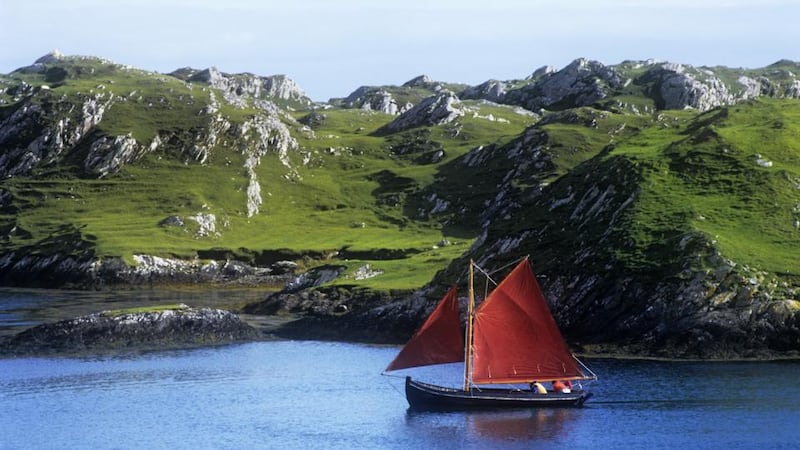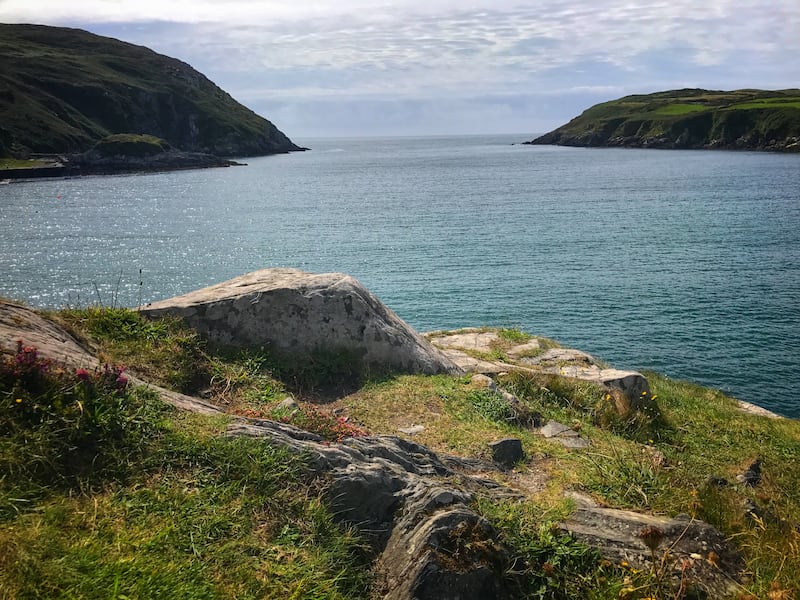There is something about islands: the sense of otherworldliness, the solitude, the rugged individuality of the people. Nature is boss in these remote places and life only endures within the tightly bonded and resilient communities that so often have fired big imaginings among writers, artists and poets. When I arrive to an island, everything seems to slow down; suddenly there seems ample time to take in the views, chat with the locals or just smell the flowers. A sense of stepping off the 21st-century treadmill has drawn me time and again to Ireland’s small offshore landmasses, and below I have listed six of my favourite islands to visit.
Rathlin island
Co Antrim
Tucked away in the northeast corner of our island, Rathlin is quite a journey from the south. Yet, what brings me to this island in the ancient Sea of Moyle – where the Children of Lir spent 300 years, according to legend – is an unforgiving but evocative coastline. This is where the Irish and the Scots have met for centuries and created a colourful history. The only inhabited island off Northern Ireland, Rathlin is now a tranquil place but has a bloody past, with the island having been the site of many brutal massacres.
Most visitors take the Puffin Bus from the quayside to view Northern Ireland’s largest seabird colony at the magnificent Rathlin West Light Seabird Centre on the island’s western tip. Thousands of puffins, razorbills, guillemots and fulmars at Northern Ireland’s’ largest colony never fail to put on a magnificent display: wheeling and whirling, swooping and soaring in an exuberant aerial dance.
But Rathlin isn’t just for the birds, it’s also about lighthouses. The upside-down lighthouse, built into a cliff face, is the only one in Ireland with the lantern below the tower; fog would have obscured the light had it been placed higher. You can visit the rooms of the keepers as they were when the lighthouse was operational, or take two lovely walks from the harbour to the other lighthouses: the East Lighthouse (3km) and the Rue Point Lighthouse (4.5km).
Sally Rooney: ‘I enjoy writing about men ... the dangerous charisma of the oppressor class’
Alzheimer’s: ‘I’ve lost my friend and my companion,’ says Úna Crawford O’Brien of fellow Fair City actor Bryan Murray
Ryan Adams at Vicar Street: A gig that nobody will forget anytime soon, but perhaps not for all the right reasons
Tory island
Co Donegal
The most isolated of the inhabited Irish islands, Tory was the seat of King Patsy Dan Rodgers until 2018. Electing a sovereign epitomises the rugged individuality of the islanders, who survived in a treeless land of winter gales and infertile soils. In 1974, a huge storm isolated the island for over seven weeks. An offer to resettle all islanders on the mainland followed, but most refused to leave their beloved Tory.
And their fortitude paid off. With its distinctive Irish-speaking culture, the island has become a Mecca for discerning tourists. Famously rat-free, Tory is a great place to hear the rare call of the corncrake. Visitors can also view examples of a distinctive style of painting known as the Tory School, created by the islanders, which are displayed at the Island’s James Dixon Gallery.
What I like about Tory is how easy it is to explore. Walk southeast from the harbour and a dramatic landscape unfolds of great sandstone cliffs and sea stacks, including the famous Shark’s Head Rock. Then it is on to the ancient promontory fort of Dún Bhaloir, located on a peninsula surrounded on three sides by enormous cliffs. Great views along the Island’s rugged northeast coastline and across to Errigal and the other Donegal Mountains are your reward. Return to the harbour and go west towards the lighthouse to enjoy great Atlantic swells. Circle back by beautiful Ardlaheen Point, where sits the studio of artist Derek Hill, who did much to make the island an artistic haven. Then return to the harbour, taking in the Round Tower and ancient Tau Cross.
[ Life on Tory Island, where just one child attends the local secondary schoolOpens in new window ]
Inis Meáin
Co Galway
The distinctive culture of the Aran islands has attracted tourists for generations. Inis Mór and Inis Oírr are hugely popular with day trippers arriving each morning in tidal waves. I have a special grá for the middle island, however, since it remains aloof from mass tourism and continues as a genuine outpost of Gaelic traditions. English is rarely spoken by the islanders and few concessions are made to mass tourism. In many ways, the beauty of Inis Meáin arises from the fact that there is less to do. Simple pleasures take precedence over dedicated attractions, such as enjoying the enchanting ocean views, rambling the traffic-free lanes or exchanging the occasional dia dhuit with the self-effacing locals.
You won’t, however, absorb the special atmosphere unless you stay overnight. Then, you’ll have time to walk the Inis Meáin Way, explore the great stony desert to the south and visit the improbably lavish fort of Dún Chonchúir. You can also meditate at the clifftop seat where John Millington Synge found a wellspring of inspiration for his greatest plays or visit the house where he stayed, which is now a museum. When night falls the silence and darkness become almost palpable with just one place to go. Sooner or later, almost everyone will arrive at the island’s only pub and most likely be drawn into a session for the remainder of the evening.
Inishbofin
Co Galway

If you want to visit an island where holidaying comes easy, then Inishbofin is the place for you. One of the most touristic of Irish islands, it has a well-developed infrastructure for visitors. And you will be following in the footsteps of literary heavyweights such as Ted Hughes, Sylvia Plath, Cecil Day Lewis, Louis MacNeice, and Seamus Heaney, who all visited and loved the island.
The island, which has three hotels and ample other accommodation, is famous for its stunning beaches of white sand. What I like most are, however, opportunities for the finest hiking and easiest cycling. Among these, the 8km Cloonamore Loop, leads you to the Island’s memorable northeast, with the mutating colours of the Connemara mountains as a magnificent backdrop. Highlights of this walk are the eye-watering white sands and row of Fishermen’s cottages at the East End Beach, which could be straight out of the Greek islands. The Westquarter Loop takes in some exhilarating Atlantic scenery, going by great blow holes, a sea arch and the Stags Rocks where the island’s seal colony dwells. The Dún More Cliffs, the Iron Age promontory fort and picturesque Trá Gheal beach are other highlights, along with views of uninhabited Inishshark island. Later, the darkened island will probably echo to the sound of lilting tunes, for Bofin has a strong musical heritage and its own céilí band.
[ Rambling on the white sands of Inishbofin, Co GalwayOpens in new window ]
Clare island
Co Mayo
Islands have a way of surprising us, and you wouldn’t expect to find one of Ireland’s most challenging hillwalks on an offshore island. From the pier to the Northern Lighthouse, over lonesome Knockmore (462m) to the Napoleonic Signal Tower and then back to the pier, is a tough, but rewarding, five- to six-hour challenge not normally associated with island walking. I did this walk once, but it’s the mixture of the remote and unspoilt with the modern that makes Clare island rewarding for me. For those not into challenging walks, there are gentler rambles around the eastern end of the island and plenty of echoes from the past. Clare Island Abbey, a 13th-century Cistercian foundation, is reputedly the last resting place of pirate queen Grace O’Malley. The island was her stronghold, and from here she organised a campaign of piracy and rebellion against English rule that made her a folk hero and later symbol of female empowerment. Inside the Abbey you can enjoy the beautiful stonework on the O’Malley tomb, while the walls and ceiling are decorated with awe-inspiring medieval paintings.
Cape Clear island
Co Cork

Ireland’s most southerly land mass, off the Cork coast, has a dedicated Irish-speaking community and a landscape of steep, rolling hills. Island living is all about the collective, and what I like most about Cape Clear is the spirit of self-reliance that permeates its ruggedly resilient people.
Comharchumann Chléire is the vibrant co-operative that has, since 1969, done much to maintain the island community. It runs the Tourist Office and Craft Shop, the Enterprise Centre, the Heritage Museum, the Island Bus Service, and the Irish College. And latterly, the islanders have come together to create Ireland’s only offshore distillery. It relies on natural ingredients harvested on the island including honeysuckle, fuchsia and seaweed, and has already won several awards. And you can also watch goats being milked, and buy local cheese and ice cream at the enterprising Chléire Goat Farm.
But the island isn’t all about enterprise. On arrival, the spectacular beauty of the North Harbour is all you need to realise that this is a place apart. This is one of the best locations to watch migratory birds in Europe. During the spring and late summer, great flocks of songbirds can be observed moving to and from their breeding grounds. There are also two bracing walks offering memorable views of the coastline and ocean. The Cnoicín’s Loop is ideal for those seeking a gentler outing, while the Gleann Loop is a bigger challenge but rewards with views over the South Harbour to the iconic Fastnet Lighthouse.

















